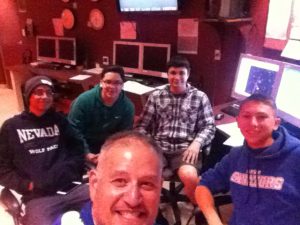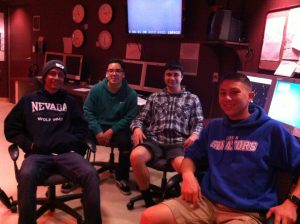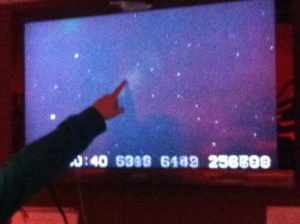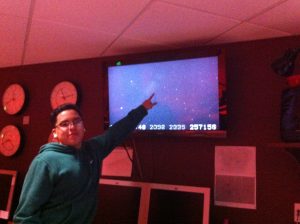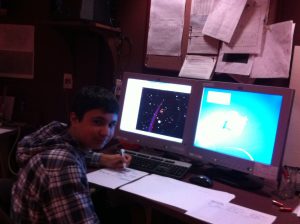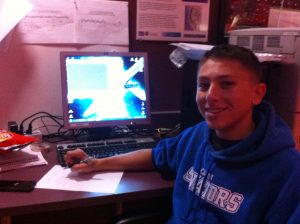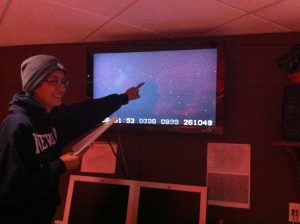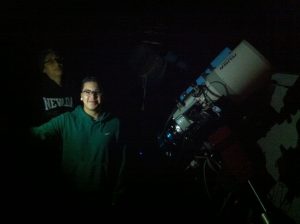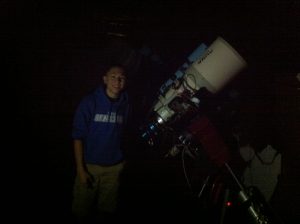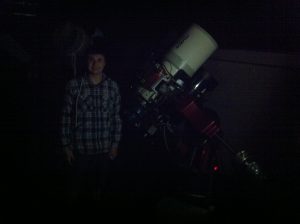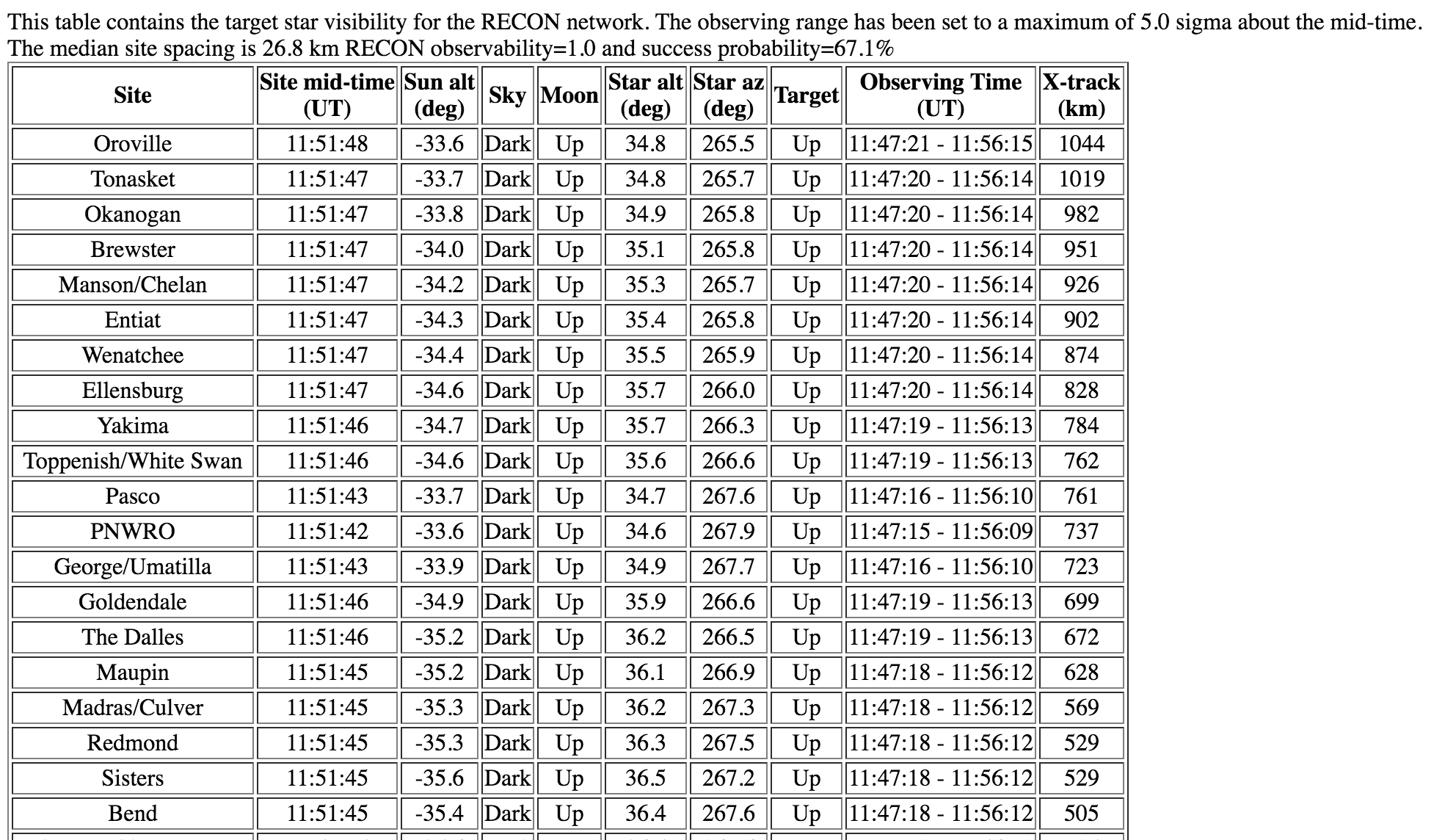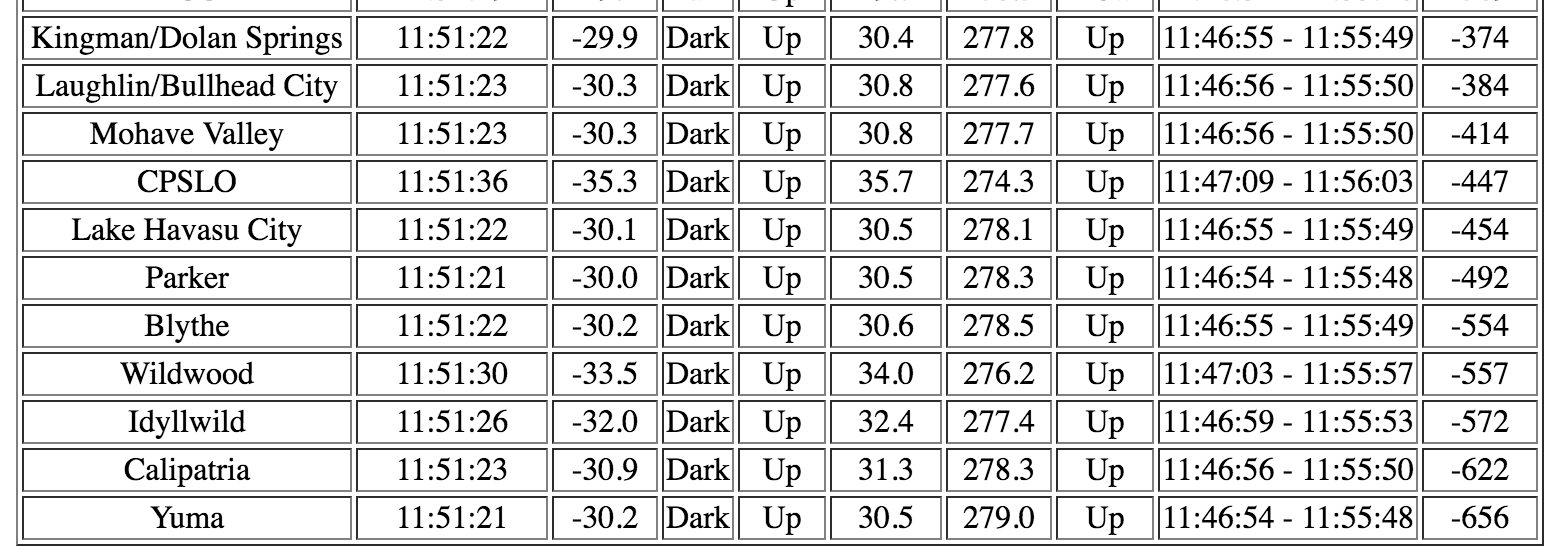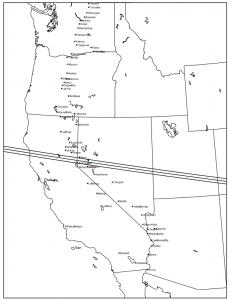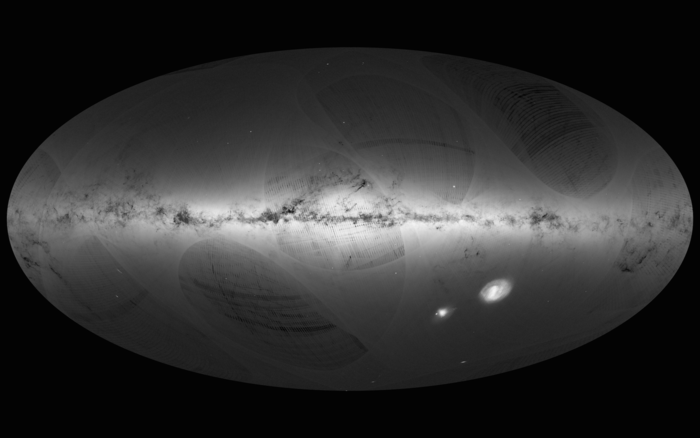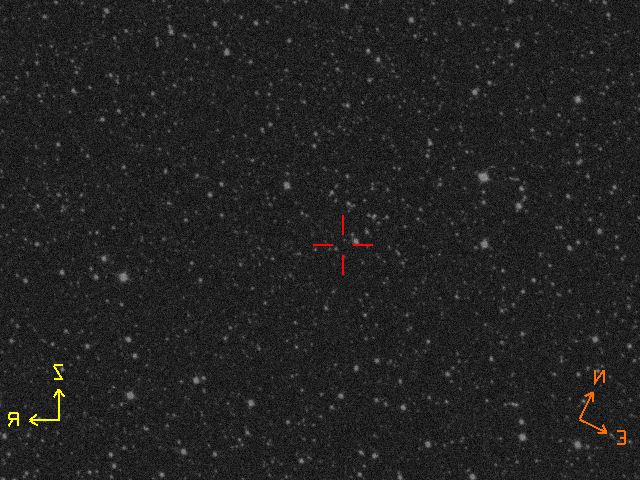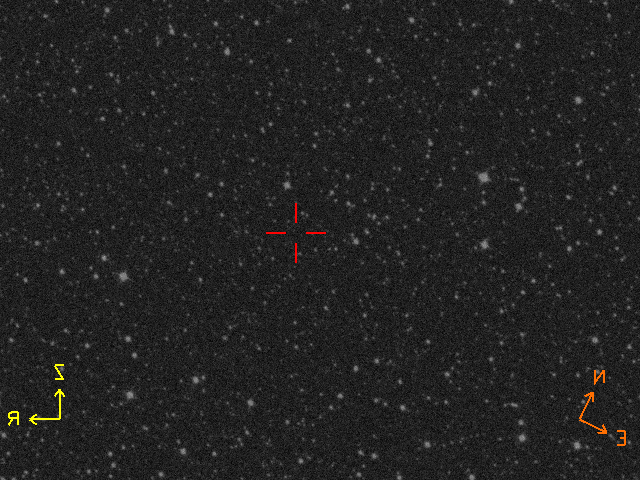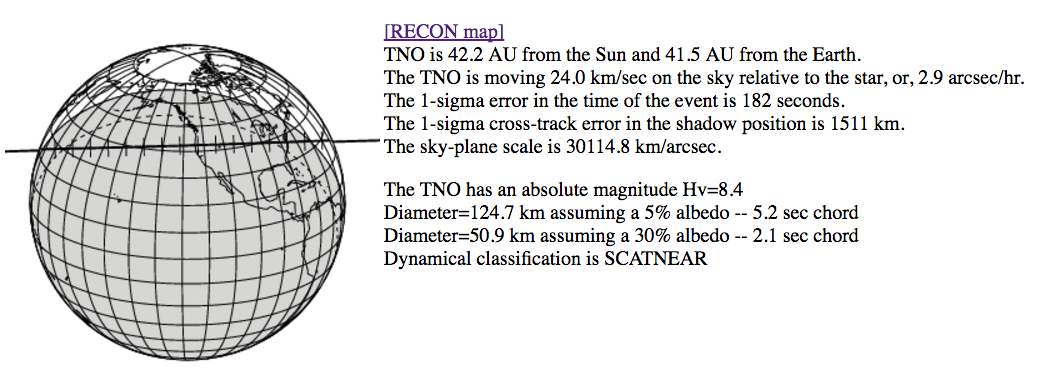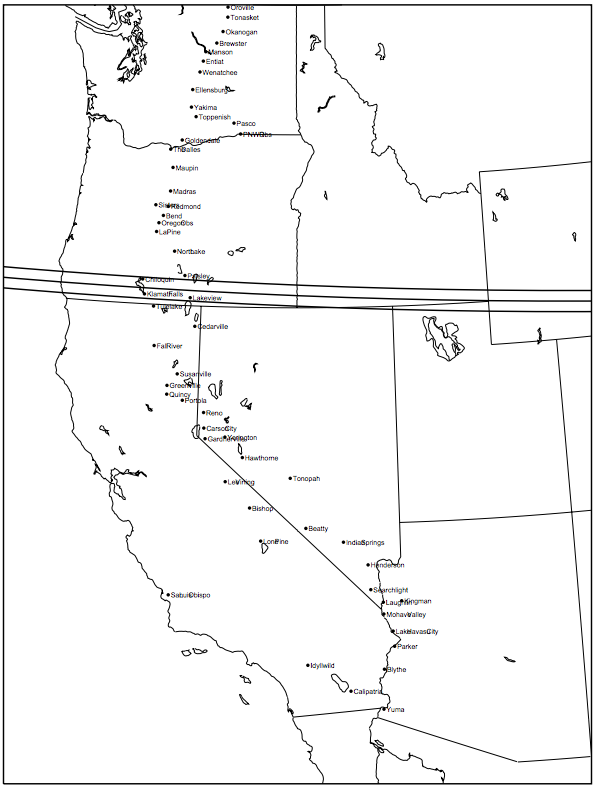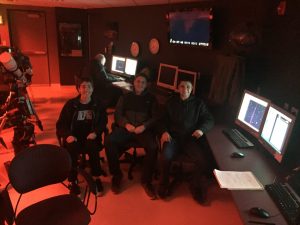
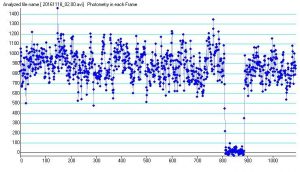
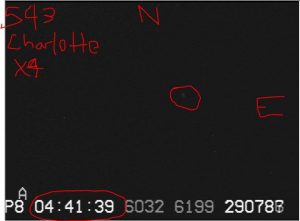
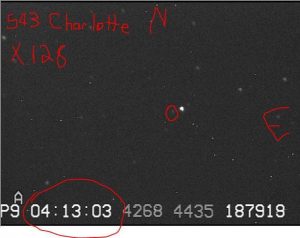
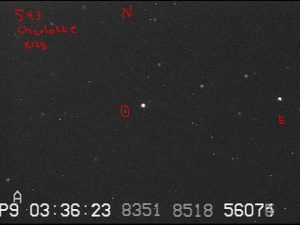
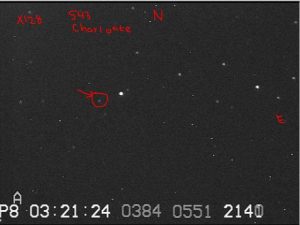
Category Archives: RECON Science
Reading RECON Event Detail Page
As RECON prepares for our our upcoming campaign early Wednesday morning this week, we thought we would take this opportunity to point out some of the interesting information found on the Event Detail Page for each RECON event.
For our upcoming event, teams should print out both of the following important webpages:
- Event Page for 08FC76: Provides sense-up, star chart, and star field image
- Event Detail Page for 08FC76: Provides loads of information described below
Event Overview:
The Event Detail Page for every campaign starts with useful information characterizing the event.
This introductory section provides lots of cool details:
- An object named (281371) 08FC76 is going to occult a star named UC4-565-008609.
- The predicted shadow reaches the point closest to Earth’s center at 11:55:36 Universal Time on November 23, 2016.
- We provide J2000 coordinates (the RA and DEC of the target star back in 2000) and equinox of date coordinates (the RA and DEC for the star today). Note that the coordinates are close but not exactly the same because Earth is slow precessing (or wobbling) on its axis. Our CPC-1100 telescopes use equinox of date coordinates.
- The target star is faint — magnitude of 14.6 using a Red (R) filter — but about 100x brighter than the TNO — magnitude 19.3 using a Visible (V) filter). Every 5 orders of magnitude is 100 times fainter. RECON setups can measure down to about magnitude 16, which means our sites will be able to record the star but will record no signal when the fainter TNO is passes in front of it —fingers crossed!
- The waning crescent Moon should not be an issue for this campaign. It is only 29% illuminated and reasonably far away (115 degrees) from the target.
- For our upcoming event, the centerline passes directly over the RECON network. Click the link on the page for a detailed RECON map of the network.
- To the right of the globe are details about the position, motion, size, and dynamical classification of the TNO. In this case, we are dealing with a Centaur which, at 10.6 AU, is currently just outside the orbit of Saturn. Note that we don’t know the actual albedo, or reflectivity, of the Centaur — that’s another thing we will be able to determine if we measure the object’s size.
- The 1-sigma uncertainty in time for the event is 47 seconds and the cross-track uncertainty is 595 km. This means that there is a 68% chance that the prediction times listed are good to within 47 seconds, and a 68% chance that the shadow will land within 595 km of the centerline shown. This is why we need so many telescopes and need to record video lasting longer than a few minutes.
Star Training Set:
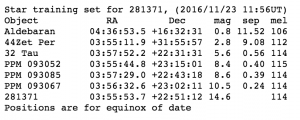 Next, we provide teams with a star training set. This is a list of 5-6 stars, in addition to the target star, that can be used to provide an indication of how accurately the telescope is aligned and in what direction. You’ll notice that the magnitudes of the stars listed are going from brightest (mag 0.8) to dimmest (mag 14.6), and that the separation between the star and the target is getting smaller (from 11.52 degrees down to 0.24 degrees). By pointing the telescope at each object, the team can get a sense of where the target is likely to appear in the camera field of view when they use the final coordinates for TNO (281371) 08FC76.
Next, we provide teams with a star training set. This is a list of 5-6 stars, in addition to the target star, that can be used to provide an indication of how accurately the telescope is aligned and in what direction. You’ll notice that the magnitudes of the stars listed are going from brightest (mag 0.8) to dimmest (mag 14.6), and that the separation between the star and the target is getting smaller (from 11.52 degrees down to 0.24 degrees). By pointing the telescope at each object, the team can get a sense of where the target is likely to appear in the camera field of view when they use the final coordinates for TNO (281371) 08FC76.
Star Chart:
Following this, an automatically generated star chart shows nearby stars along with a green rectangle representing the RECON camera field of view. Note that we are still tweaking how this star chart displays, and for now the star chart provided on the Event Page is a better depiction of the star field at the actual time of the event.
Site Table:
Finally, we provide a table listing all of our RECON sites along with useful information unique to each location. Among other information, the text just above the table provides an indication of the median spacing of the RECON network for this event (26.8 km) and the probability of success assuming clear skies (67.1%). These REALLY good odds for TNO occultation astronomy are only made possible by our awesome network of team members spanning a baseline of roughly 1,700 km. The probability takes into account the uncertainty in the position of the TNO and the target star, the estimated size of the object, and the median spacing of telescopes across the network.
For each RECON site, you can read off the following information:
- For all of our sites the Sun is down (negative altitude), the sky is dark, and the Moon is up.
- The position of the star (star altitude and azimuth) is provided for each site. 10 degrees corresponds to a fist held at arms length. Due north is 0 degrees azimuth, 90 degrees is east, 180 degrees is south, and 270 degrees is west. For Oroville during the event time, the star will be 34.8 degrees above the horizon (about three and a half fists) and in the direction of 265 degrees, or just 5 degrees south of due west.
- Remember the 1-sigma cross track error of 595 km above? For each site the table lists how far the site is from the centerline prediction. Note that all RECON sites south of Madras/Culver (X-track = 569 km) are within the 1-sigma zone.
All times on the page are in Universal Time (UT) and need to be converted to local time. Our teams on Pacific Standard Time (PST) are 8 hours behind UT, and our teams on Mountain Standard Time (MST) are 7 hours behind UT. Let’s take a look at three examples:
- The recording window for Oroville is 11:47:21-11:56:15 UT (see above). Because they are on Pacific Time, our Oroville team will subtract 8 hours and record from 03:47:21-03:56:15 PST.
- The recording window for Yuma Arizona is 11:46:54-11:55:48 UT (see below). Because Yuma (and all of Arizona) are on Mountain Time, our team there will subtract 7 hours and record from 04:46:54-04:55:48 MST.
- Our team in Laughlin/Bullhead City, with a start time of 11:46:56 UT, is in the funkiest situation (see below). If the team observes from Laughlin, Nevada, they will start recording at 03:46:56 PST; if they are in Bullhead City, Arizona, they will start recording at 04:46:56 MST. Both are the same Universal Time which is why astronomers prefer to use UT rather than local time!
J2000 Star Training Set (NOT for standard RECON Setups):
The final table provided on the Event Detail page is the same star training set using J2000 coordinates. Some of our volunteer sties are using scopes that use J2000 coordinates, unlike our RECON Celestron scopes. Standard RECON sites should use the star training table at the top of the page above the star chart!
RECON Prediction System at Work
As with all science, RECON is a work in progress, and we will continue to refine our predication and observation planning tools. All of the above useful information is available for each occultation prediction found on the Global TNO Event Candidate List and RECON TNO Event Watchlist. Each of these lists is updated weekly and provides predictions looking two years into the future – including our next RECON event after this week involving Centaur 14UT114 on 11 December, 2016 UT.
Best TNO Opportunity Yet!
During the week of Thanksgiving, the RECON community is looking forward to the best TNO occultation opportunity since the start of our full network last year! On Wednesday morning, November 23, around 3:55AM Pacific (4:55AM Mountain), Centaur 08FC76 will be occulting 14.6 magnitude star UC4-565-008609 in the constellation Taurus.
This event is EXACTLY the type of campaign that RECON was designed to pursue. As shown on the map here, the predicted centerline for the occultation shadow passes directly through the center of our network! Recently kicked into an orbit neighboring Saturn, Centaur 08FC76 will be only 9.6 AU from Earth. Based on how well we know the orbit for this object, the 1-sigma cross-track uncertainty in the shadow path prediction is only 595 km. Importantly, this places every RECON telescope site from Madras, Oregon to Idyllwild, California within this zone of high probability for detection. That’s 43 of our 60 communities!!! Based upon our calculations, there is at least a 67% probability that RECON will capture this event, more than double any of our previous events.
And, as with all RECON events, each telescope site is crucial for mapping out the region of space around this TNO. Does this Centaur have a smaller moon . . . or moons? Does it have rings? How big is it actually? How bright is it? What is its shape? We plan to address all of these questions and more through data collected during this upcoming holiday campaign!
Marc has also taken the extra step of incorporating recent data from the Gaia Mission in to the prediction above. With the additional precision provided on the position of the target star, the prediction path has remained in the center of the network. This makes for an even stronger prediction that the shadow of this Centaur will passing over our network on the morning of November 23. This is the highest probability event we have had since the start of the project!
For more information on this event, visit the Event Page and Event Detail Page for 08FC76. RECON Teams are asked to sign up for the event using the RECON Campaign Signup Form. We are extremely thankful to all of our RECON team members for supporting this upcoming campaign and for all of the preparation and dedication that has gotten us to this point.
Clear skies … south of Kingman
During our event last weekend, cloudy skies and rain impacted most all of our Washington, Oregon, California, and Nevada sites. The clouds parted south of Kingman and at least five communities along the Colorado River collected data along with pockets in Lee Vining, Searchlight, and elsewhere. We will be analyzing these video files in the coming week. For a snapshot of how things went for each of our telescope sites, you can check out an Event Summary for 12UT68.
Teams that have not yet submitted a RECON Campaign Observation Report Form for the event have until this Sunday evening (one week following the event) to complete this dataset. Also, stay tuned for our next event on the Wednesday morning before Thanksgiving. This is going to be our best TNO occultation opportunity since the start of the RECON Project!
Gaia Billion-Star 3D Map of Galaxy
This past week, the European Space Agency released its first dataset produced by the Gaia Mission, a spacecraft in orbit around the Earth-Sun second Lagrange point (L2). This dataset provides precise position and brightness information for over 1.1 billion stars in the Milky Way and satellite galaxies, along with distances and proper motions for 2 million of these. With still more data to come, Gaia provides the most comprehensive 3-dimensional map of the stars in our galaxy.
The release of this dataset is extremely significant to RECON, as it essentially eliminates previous uncertainties in the positional information of occultation target stars. This will allow us to make more precise predictions of occultation paths for trans-Neptunian Objects (TNOs). Uncertainties remain in our measurements of TNO positions, but Gaia provides a significant improvement to our occultation prediction efforts.
RECON Team Meeting Rocked!
Thanks to the 70 team representatives – included 10 students – who joined us in Carson City back in August for our first annual RECON Team Meeting! The meeting was a very productive opportunity to reconnect, review recent publications, and prepare for future research campaigns. For copies of presentations and materials, visit our Presentations and Educational Resources Page. Below is a group photo from the event:
We also discussed plans for our next team meeting, which will likely be held mid- to late-October 2017 up in the Pacific Northwest!
Pluto Star Fields for Carson City Meeting
RECON Team Meeting August 3-5
RECON is gearing up for its first annual Team Meeting to be held in Carson City, Nevada, August 3-5. This science team meeting is an opportunity for representatives from all of our community teams to come together to talk about recent science results, upcoming campaigns, and procedural updates on the project.
More information on the RECON Team Meeting Webpage. Team representatives should use the REGISTER NOW link on that page to sign up for the meeting.
Summer RECON Events
As RECON rolls into the summer months, Marc has been busy doing follow-up observations to provide up-to-date predictions for three upcoming summer TNO occultation events. Based upon this recent work, we are currently planning the following official and optional campaigns:
- June 20 08:48 UT – Scattered Disc Object 08JO41 (Official Full Campaign)
- June 26 06:49 UT – Classical Kuiper Belt Object Quaoar (Optional Campaign)
- July 23 05:15 UT – Classical Kuiper Belt Object Quaoar (Optional Campaign)
OFFICIAL FULL CAMPAIGN – 08JO41 on June 20 around 08:48 UT
With an estimated size of 50-125 km, Scattered Disc Object 08JO41 is exactly the type of trans-Neptunian Object that the RECON Network was designed to measure. Based upon astrometry collected this past week, the predicted centerline for this event is over southern Oregon with a 1-sigma cross-track uncertainty of 1511 km.
Based upon our uncertainty calculations, there is a 30% chance that the shadow will pass over a portion of the network. And as with all full campaigns, all telescope sites from Yuma to Oroville provide important data to probe the regions around 08JO41 for moons and rings. Thanks to all RECON teams for gearing up for this full campaign event.
OPTIONAL CAMPAIGNS INVOLVING QUAOAR
With a diameter of around 1110 km, Classical Kuiper Belt Object Quaoar is roughly half the size of Pluto and has a small moon named Weywot.
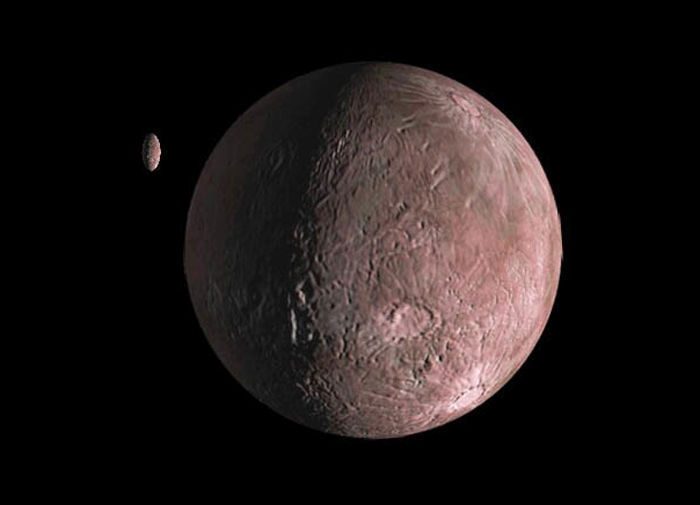
An artist’s conception of Quaoar and its small moon Weywot.
Credit: NASA/JPL-Caltech/R. Hurt (SSC-Caltech)
– See more at: http://www.space.com/25817-quaoar.html#sthash.DYFAwmeA.dpuf
There are two upcoming close approaches that could bring the shadow path of this large KBO over the RECON network. The first is on June 26 UT and the next is on July 23 UT. If the object does pass over the network, multiple telescope sites would record this occultation. Marc and several other observers are conducting on-going observations to pin down the probabilities of success for RECON on these two dates (which are currently at 3.2% and 1.4%, respectively). However, there is something peculiar about how this recent data is matching up with previously collected orbital data. Given this, we are announcing these events as optional campaigns for the network and encouraging all RECON teams that are available to participate. We will provide weekly updates leading up to these events, so stay tuned.
2016_05_26 … RECON Carson
Carson High Students Dom Cerniglia, Aaron Flieger, Edgar Avila, & Sergio Maqueda; Observing Scattered Disc Object, 99CY118
